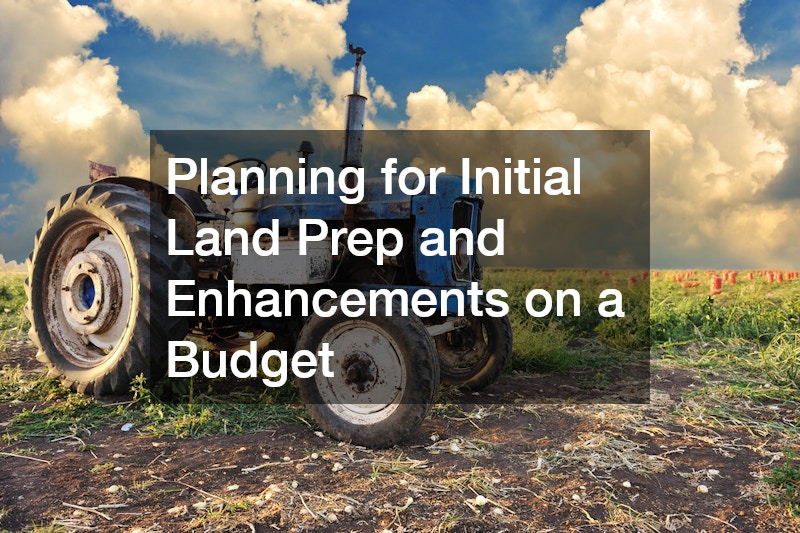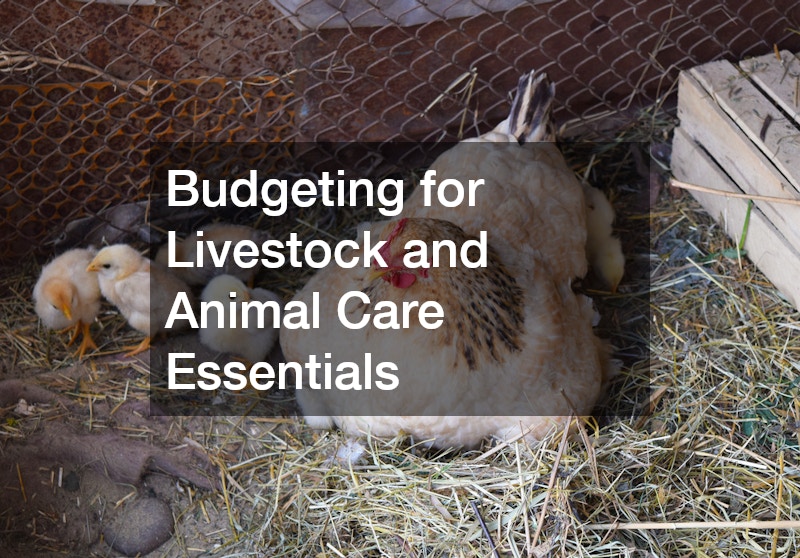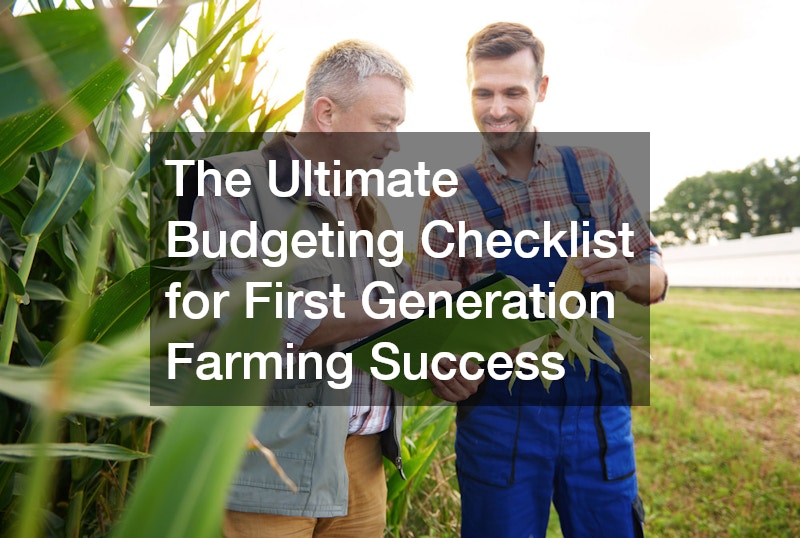
Embarking on a journey in first generation farming is both exciting and daunting. As new entrants in the farming industry, first generation farmers often face a steep learning curve, compounded by the financial burdens of starting from scratch. This guide aims to provide detailed insights into crafting a budget that not only addresses immediate needs but also considers long-term sustainability.
Understanding the financial demands of first generation farming can help you strategically allocate resources, ensuring every dollar has maximum impact. From startup costs for essential supplies to managing ongoing operational expenses, an informed budgeting approach is crucial. As we delve into various facets of farm budgeting, including land prep, infrastructure, and sustainability, it’s essential to consider making informed choices to facilitate your new farming venture.
In this article, we’ll explore in-depth strategies for optimizing your budget across multiple domains in first generation farming. By engaging local services and choosing sustainable solutions, you can enhance productivity while maintaining fiscal responsibility. Let this guide be your roadmap to successfully navigating the financial complexities of starting your own farm.
Estimating Start-Up Costs for Essential Farm Supplies and Equipment

For first generation farmers, acquiring essential farm supplies and equipment is often one of the most significant initial expenses. Agricultural machinery, for instance, ranges in cost and functionality, and selecting the right equipment can make a substantial difference in productivity. By purchasing in bulk, such as bulk wood shavings or bulk organic fertilizer, you can reduce costs and ensure a reliable supply.
Setting up an efficient procurement plan prevents unexpected shortages and cost overruns. Consider collaborating with suppliers to negotiate better prices for essentials needed in vast quantities. First generation farming demands a thorough understanding of both market dynamics and specific farm needs to make informed purchasing decisions.
It’s also beneficial to invest time in comparing different options available for agricultural machinery. Since these are typically high-cost items, opting for used or refurbished machines might offer significant savings without compromising on performance. For first-time farmers, this approach not only minimizes upfront costs but also allows for gradual scaling as the farm grows.
Planning for Initial Land Prep and Enhancements on a Budget

Effective land preparation is crucial for planting and cultivating crops, but it need not be costly if approached strategically. First generation farming often begins with assessing the land’s current condition and prioritizing necessary enhancements. Hiring a land surveyor can provide insights into the specific modifications required, helping to avoid unnecessary expenses.
In many cases, small-scale farmers can utilize local landscaping services for basic land prep, reducing costs compared to larger companies. These local services often provide expertise in sod installations and other vital enhancements at competitive prices. Embracing such partnerships can optimize land preparation expenses without compromising quality.
Budget-conscious decisions in initial land prep can extend to choosing affordable, sustainable materials and techniques. Ongoing improvements should be planned and implemented as the farm evolves, allowing for manageable financial outlays over time. This gradual approach aligns well with the resource constraints typically faced in first generation farming.
Calculating the Cost of Water and Soil Management for Your Crops

Water and soil management are pivotal components of successful first generation farming. Meeting irrigation needs efficiently is critical, particularly in arid regions or during times of drought. Opting for bulk water delivery services can be a cost-effective choice when local water sources are insufficient or too costly to tap into.
Implementing advanced water management systems allows farmers to conserve resources and reduce expenses. Efficient drip irrigation systems not only prevent water wastage but also lower operational costs over the long term. First generation farmers should prioritize investments that enhance resource efficiency to create more sustainable farming practices.
Moreover, soil management goes hand in hand with water strategies. Using nutrients wisely and ensuring the soil’s health through regular testing and enrichment can lead to better crop yields. Encouraging natural soil regeneration and opting for bulk organic fertilizers can further optimize soil health without excessive spending.
Creating a Budget for Sustainable Fertilizer and Soil Enrichment Solutions
Applying sustainable fertilizer and soil enrichment solutions aligns with responsible first generation farming. The emphasis should be on long-term soil health that supports consistent, high-quality yields. Through careful selection and application of bulk organic fertilizer, farmers can achieve effective soil nutrition without excessive chemical use.
A critical aspect of budgeting for fertilizers involves understanding the soil’s current nutritional needs and adapting the enrichment plan accordingly. Soil testing services help determine deficiencies and needs, facilitating targeted application of nutrients. This precision saves costs and reduces environmental impact, adhering to sustainability goals.
To maintain optimal soil health, first generation farmers might also partner with a landscape lighting contractor to install lighting systems that support photosynthesis for crops. This investment in infrastructure enhances plant growth while simultaneously contributing to farm security. Balancing immediate needs with long-term gains ensures the farm remains environmentally responsible and economically viable.
How to Budget for Farm Infrastructure to Maximize Productivity
Investing in infrastructure is a pivotal step for maximizing farm productivity in first generation farming. Strategic selection and placement of infrastructure, from planting grids to barns, can significantly enhance operational efficiency. A thoughtful assessment of current and future needs ensures that infrastructure investments align with growth plans.
Leveraging modern technology and sustainable building materials may involve higher initial costs but offer substantial long-term savings. For instance, greenhouses can extend growing seasons and protect crops against adverse weather, providing a critical productivity boost. Assessing the return on investment for various infrastructures supports informed budgeting decisions.
While large-scale infrastructure projects may appear daunting, prioritizing essential and high-impact installations first is wise. As the farm grows, phased implementation allows for decisively managing capital expenditures. By aligning infrastructure projects with strategic farm goals, first generation farmers can secure sustained operational success.
Considering Fencing Needs in Your Initial Farm Budget Plan
A comprehensive farm budget for first generation farming should include considerations for fencing, which play a critical role in protecting crops and livestock. Whether using traditional materials or more innovative solutions, partnering with a reputable fence company can help ensure robust and effective installations.
Fencing not only secures the perimeter but also aids in managing livestock and delineating crop areas. Cost-effective options, such as installing bulk orders of basic materials, can keep this expense in check. However, quality and durability should remain top considerations to prevent future costly replacements or repairs.
Incorporating maintenance costs into the budget ensures that the fencing continues to offer protection over the years. Frequent evaluations and engagements with local services for regular upkeep can extend the life of the installations. Such foresight in budgeting can help mitigate unforeseen financial burdens, enhancing the farm’s overall sustainability.
Setting Up Efficient Irrigation Systems to Save Water and Money
Irrigation systems are vital for supporting crop growth, particularly in regions with unpredictable rainfall. First generation farming operations benefit from efficient, well-planned irrigation systems that maximize water usage and minimize waste. Technological advancements, like smart irrigation controllers, offer solutions that promise water conservation and cost savings.
Drip and sub-irrigation systems can achieve water savings of up to 90% compared to traditional methods. Such systems deliver water directly to plant roots, reducing evaporation and runoff. Investing in these technologies may require higher upfront costs but result in substantial savings and operational efficiencies in the long run.
Bulk water delivery services can complement these systems, ensuring consistent water supply even during dry spells. This approach frees up time and resources to focus on other aspects of farm management. As first generation farmers develop proficiency in managing water resources, the integration of advanced systems supports increased yields with lower costs.
Budgeting for Livestock and Animal Care Essentials

For first generation farmers venturing into livestock management, budgeting for animal care is paramount to ensuring healthy and productive animals. Inputs such as feed, bedding, and medical care contribute significantly to expected agricultural costs. Bulk wood shavings and feed purchases offer opportunities to reduce expenses while maintaining quality.
Setting aside funds for preventative health care, including vaccinations, routine check-ups, and emergency veterinary services, aligns with best practices in animal husbandry. Ensuring livestock remains disease-free can prevent unforeseen financial shocks and support sustainable herds. As such, careful attention to these details is critical when budgeting for first generation farming operations.
Additionally, infrastructure supporting animal care requires consideration. Providing shelter, grazing, and water systems, alongside proper waste management, ensures animal welfare. Balancing the scale of initial investments with the livestock’s needs fosters a sustainable and manageable livestock operation, integral to a thriving first generation farm.
Financial Planning for Greenhouses and Crop Protection Structures
Greenhouses represent a significant investment but serve as vital assets for first generation farmers looking to extend growing seasons and enhance yields. They shield crops from adverse weather conditions, pests, and other external threats, offering controlled and optimized growing environments. While the initial costs are substantial, the return on investment in terms of crop quality and quantity can be substantial.
When planning financially for greenhouses, consider scale and material choice. Modular systems allow gradual expansion, providing flexibility as farm demands evolve. Durable materials, although pricier, provide long-term reliability and reduce maintenance costs, proving to be economically viable in the long run.
Crop protection structures, like shade nets or windbreaks, complement greenhouses by offering additional environmental control. Budgeting for these structures effectively maximizes their benefit across different seasons and crop cycles. In blending these strategies, first generation farmers enhance crop resilience and support stable income streams.
Factoring Land and Soil Surveys into Your Start-Up Budget
Land and soil surveys are indispensable tools in the toolkit of first generation farmers, offering critical insights into soil health and potential crop productivity. Engaging a land surveyor to evaluate the topography, drainage patterns, and soil characteristics provides essential data to inform planting strategies and infrastructure designs.
While initial survey costs may seem steep, they often preempt poor investment choices by highlighting underlying issues, such as nutrient deficiencies or erratic drainage. Accurate land assessments foster informed decision-making, directly influencing crop yields and operational efficiency. This upfront investment supports a tailored approach to enhancing land fertility and productive output.
Surveys also aid in regulatory compliance and sustainable land management, which are increasingly significant in modern agriculture. By incorporating these considerations into the budgeting phase, first generation farmers can align their goals with ecological and economic sustainability. Embracing this approach offsets potential pitfalls linked to uninformed land use, securing the farm’s long-term success.
Lighting and Security: Essential Considerations for Farm Safety
Security and proper lighting contribute significantly to the overall safety and efficiency of first generation farms. An efficient lighting system helps to deter theft and vandalism, while also improving nighttime productivity and safety. Engaging a landscape lighting contractor to design tailored lighting solutions can enhance both security and operational efficiency.
Strategically installing motion-activated or solar-powered lights can reduce energy costs while maintaining a secure environment. These systems are especially critical for protecting valuable assets such as agricultural machinery and livestock. In budgeting for farm lighting, it’s essential to weigh the upfront costs against potential losses from theft or damage.
Security measures should also be comprehensive, potentially involving surveillance systems or regular patrols. By integrating these facets into a cohesive budget plan, first generation farmers can mitigate risks and foster a safe, productive farm environment. Prioritizing safety ensures that both physical assets and personnel are protected, cultivating a secure atmosphere for growth and innovation.
Seasonal Budgeting for Ground Cover, Mulch, and Soil Preservation
Effective soil preservation through the use of ground cover and mulch is a strategic approach in sustainable farming practices. Seasonal planning for these materials ensures that soil retention, moisture management, and weed suppression are effectively addressed throughout the year. First generation farmers benefit from purchasing ground cover and mulch in bulk, reducing costs while ensuring consistent quality.
Mulching not only retains soil moisture but also enriches it by gradually decomposing, thus offering dual benefits. Organic mulches made from natural materials contribute to the ecocycle, supporting broader sustainability goals. Seasonal budgeting should include the cost of acquiring and applying these materials, optimizing both immediate and long-term agricultural productivity.
Ground cover plants further prevent soil erosion and improve biodiversity, critical components in any sustainable farming strategy. Incorporating these elements into a unified budget allows first generation farmers to manage resources effectively, minimizing soil degradation and fostering a robust agricultural ecosystem. A proactive approach to soil preservation aligns with the farm’s overarching vision of environmental stewardship and economic sustainability.
Working with Local Services to Save on Farm Landscape Maintenance
Collaborating with local landscaping services offers significant advantages in terms of cost savings and accessibility for first generation farmers. These services often possess area-specific knowledge that can enhance farm layout and maintenance practices. Engaging local expertise can help reduce travel expenses and ensure timely, personalized service for ongoing landscape needs.
Factors such as sod installations, regular trimming, and debris clearing fall within the purview of these services. Leveraging their experience can elevate your farm’s aesthetic appeal while maintaining functional utility. Aligning these maintenance tasks within a structured budget plan optimizes resource management and cost-effectiveness.
Furthermore, local services might offer flexible payment plans or discounts for ongoing contracts, making them an affordable option for start-up farms. By establishing a good working relationship, first generation farmers can secure reliable support and maintenance activities, ensuring the farm remains operationally efficient and visually appealing throughout the year.
In conclusion, crafting a comprehensive budget is essential for first generation farmers aiming to succeed in agriculture. By addressing the multifaceted components of farm establishment and operation, this guide provides a roadmap for making informed financial decisions. Each outlined area contributes significantly to establishing a thriving farm, balancing immediate needs with long-term sustainability.
As you navigate the complexities of first generation farming, remember the value of strategic partnerships and sustainability-focused investments. Collaborating with local providers, choosing environmentally-friendly solutions, and planning for future growth form the backbone of robust financial planning. These insights equip new farmers with the tools needed to build economically viable and environmentally responsible operations.
Ultimately, embracing the challenges and opportunities that come with first generation farming fosters a resilient and adaptive business model. By diligently managing resources and prioritizing strategic investments, you can cultivate a prosperous venture that leaves a lasting legacy. Have confidence in your journey and let this guide serve as a valuable resource as you grow your farm.



